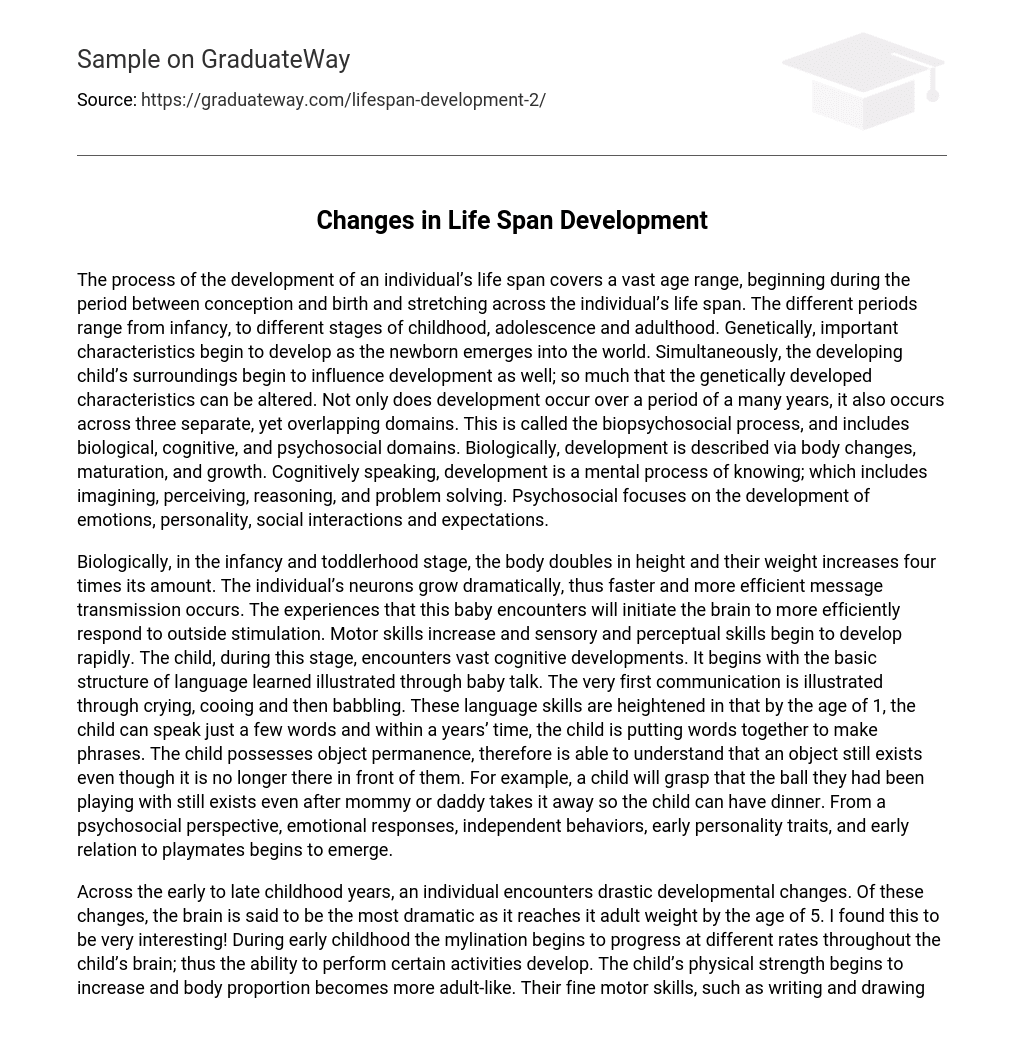The process of the development of an individual’s life span covers a vast age range, beginning during the period between conception and birth and stretching across the individual’s life span. The different periods range from infancy, to different stages of childhood, adolescence and adulthood. Genetically, important characteristics begin to develop as the newborn emerges into the world. Simultaneously, the developing child’s surroundings begin to influence development as well; so much that the genetically developed characteristics can be altered. Not only does development occur over a period of a many years, it also occurs across three separate, yet overlapping domains. This is called the biopsychosocial process, and includes biological, cognitive, and psychosocial domains. Biologically, development is described via body changes, maturation, and growth. Cognitively speaking, development is a mental process of knowing; which includes imagining, perceiving, reasoning, and problem solving. Psychosocial focuses on the development of emotions, personality, social interactions and expectations.
Biologically, in the infancy and toddlerhood stage, the body doubles in height and their weight increases four times its amount. The individual’s neurons grow dramatically, thus faster and more efficient message transmission occurs. The experiences that this baby encounters will initiate the brain to more efficiently respond to outside stimulation. Motor skills increase and sensory and perceptual skills begin to develop rapidly. The child, during this stage, encounters vast cognitive developments. It begins with the basic structure of language learned illustrated through baby talk. The very first communication is illustrated through crying, cooing and then babbling. These language skills are heightened in that by the age of 1, the child can speak just a few words and within a years’ time, the child is putting words together to make phrases. The child possesses object permanence, therefore is able to understand that an object still exists even though it is no longer there in front of them. For example, a child will grasp that the ball they had been playing with still exists even after mommy or daddy takes it away so the child can have dinner. From a psychosocial perspective, emotional responses, independent behaviors, early personality traits, and early relation to playmates begins to emerge.
Across the early to late childhood years, an individual encounters drastic developmental changes. Of these changes, the brain is said to be the most dramatic as it reaches it adult weight by the age of 5. I found this to be very interesting! During early childhood the mylination begins to progress at different rates throughout the child’s brain; thus the ability to perform certain activities develop. The child’s physical strength begins to increase and body proportion becomes more adult-like. Their fine motor skills, such as writing and drawing, begin to develop but at a slow pace. The motor skills of boys begin to differ from that of the age related girls, as gender differences emerge. During this stage, the child begins to say many words and develops a word bank of approximately 14,000 words. This is when metacognition emerges. During the early years of childhood, the recognition of gender differences among playmates begins to develop and their play becomes much more imaginative. Both parenting styles and the child’s environments play such a significant role in the child’s development.
During the early adolescent years, a girl’s growth spurt peaks while a boy’s is just beginning. Sexual maturation heightens during these years, as females begin to menstruate and males to ejaculate. Cognitively, these individuals grow by leaps and bounds. Their identity and sexual orientation begins to emerge and peer pressure becomes very evident. The individual begins to become a planner and has ease in remembering ideals and facts. Cliques are developed among peer groups, individuals begin to stray away from their families and morals and values are developed.
During adulthood physical functioning will increase during an individual’s twenties and will then peak during their thirties. Body shapes changes again. I just entered into my thirties, and I can definitely see the changes in my body occurring constantly. Just the opposite of the earlier years, our organs efficiency begins to diminish yearly. I found this to be a scary thought. Physically, our characteristics begin to change as we develop gray hair, wrinkles, and increase in weight and decrease in muscle. Finally, our wisdom and expertise peak! We have many life experiences by this point and they provide us with richness in wisdom. During the early adulthood years, individuals are concentrated on success in their professions, in finding the perfect mate, and having the ideal family.
Across our life span, we encounter many changes. We change on biological, cognitive and psychosocial level. Each individual will encounter these changes at a different pace, at a different age and at a different level. I found this to be very interesting to see the norm of changes that occur over our life span and ultimately compare those to my personal changes and growth thus far in my life.





